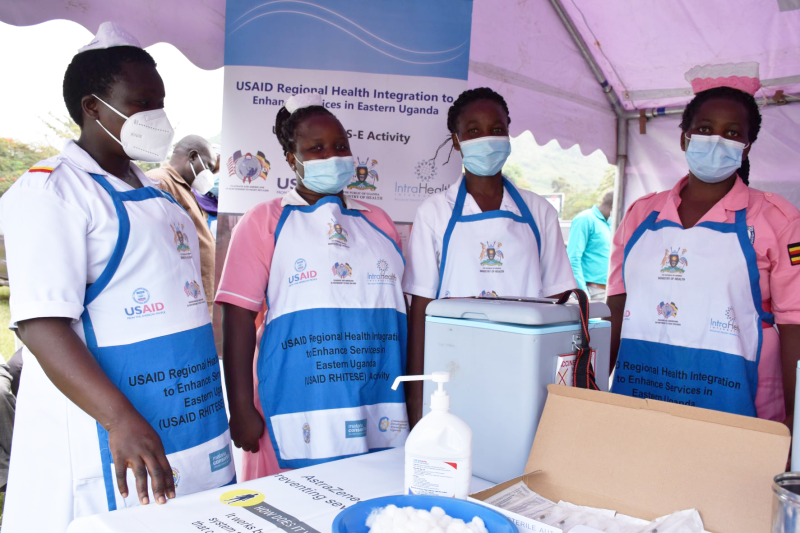Where We Work
See our interactive map


IntraHealth International’s Regional Health Integration to Enhance Services in Eastern Uganda (RHITES-E) project is partnering with the government of Uganda to offer COVID-19 vaccination drives that will provide more people with protection from the virus before a stockpile of the country’s vaccines expire at the end of August.
Uganda will have to destroy about 1.2 million vaccine doses by the end of August if they remain unused. Vaccine waste is a crucial issue for many countries, reaching as high as 30% in some areas. In Uganda, health facilities often receive vaccines from the Uganda National Medical Stores, but due to insufficient demand, they are left unused and expire. So the Government of Uganda and USAID are working together to provide vaccines to more people through accelerated COVID-19 vaccination campaigns.
In eastern Uganda, RHITES-E works with district COVID-19 task forces to plan these vaccination drives and create more demand for COVID-19 vaccines. So far, RHITES-E’s partner districts have received 469,426 doses (13% of total doses received countrywide) across three rounds of mass vaccinations. They have already administered 326,951 of these doses—a 69.6% overall uptake rate.
“There was a time when vaccines were nearly expiring and it created a crisis."
One RHITES-E partner district, the Mbale District, initially struggled with low vaccine uptake. “There was a time when vaccines were nearly expiring and it created a crisis,” says Agnes Masagwayi, the Mbale District senior health educator. “We needed to go out in the communities to vaccinate people.”
When the district’s rate of vaccine administration slowed, local leaders worked with RHITES-E to rally communities to embrace vaccination by:
Chesura Aisha, a local woman, got her vaccine in June at one of the outreach posts in her community. “I was happy to receive my jab,” she says. “I feel safe from COVID-19 with this vaccination.”
"We’ve utilized all of the vaccines that have been rejected by the neighboring districts."
These interventions also helped to mitigate vaccine wastage and expiration. The Mbale District collaborated with RHITES-E, district cold chain technicians, district health teams, and the Mbale Regional Emergency Operations Center to plan, forecast, roll out, and monitor an appropriate supply of COVID-19 vaccines. In some cases, RHITES-E redistributed vaccines from communities where demand was low to those where demand was high. They gauged demand in each district through forecasting, regular review, and early warning to determine where and when doses should be sent. In April 2022 alone, they redistributed 17,360 Moderna doses and 21,000 AstraZeneca doses and administered them to clients before they expired.
“We’ve utilized all of the vaccines that have been rejected by the neighboring districts either because they received them abruptly or they were about to expire,” says Jonathan Wangisi, the district health officer for the Mbale District. “The vaccination response team is committed and has planned out its vaccination efforts, which has helped us seize every opportunity to ensure people receive their vaccines.”
The district hasn't had a vaccine expire yet.
The district’s combined redistribution and campaign efforts have increased their COVID-19 vaccination uptake rate since vaccinations began in November 2021. And they haven’t had a vaccine expire yet.
“It’s crucial that all districts and health facilities administering vaccines regularly plan, monitor, and account for vaccine use continuously,” Masagwayi says. “The demand for vaccines should be commensurate with the supply. This reduces waste and ensures everyone is vaccinated.”
In the eastern region, COVID-19 vaccination uptake is at 69% for the first dose and 55% for full vaccination among the target population. RHITES-E districts now rank among the highest in Uganda for full vaccination rates (Bukedi ranks fifth and Bugisu ranks seventh among the top ten).
Now, the Mbale District is intensifying their vaccine drives for booster shots. Already 20,589 people have been boosted in the RHITES-E regions of Bukedi and Busoga.
RHITES-E is funded by the US Agency for International Development and led by IntraHealth International. Irene Mirembe and Aaron Musimenta contributed reporting for this story.
*The training ensured that all health workers involved in administering COVID-19 vaccines had adequate knowledge and skills on how to administer them as approved by the World Health Organization.



